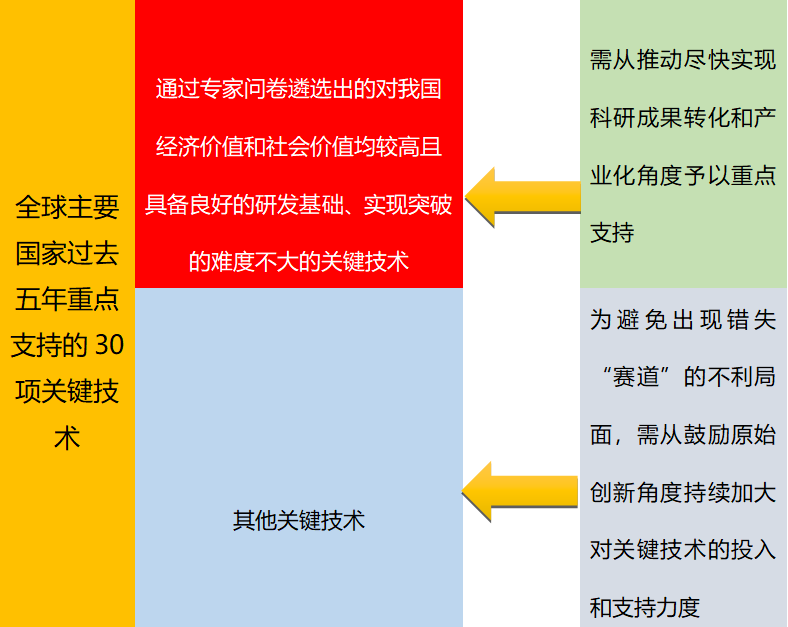
Source: Future Industry Research Center, Westlake University
Recently, the Future Industry Research Center of Westlake University released the "Future Industry Development Trend Research 2023: Future Biomedicine". The report uses artificial intelligence text analysis technology to conduct data mining and analysis of global biomedical technology, identifies the key directions of the future development of China's biomedical industry, and puts forward a series of targeted policy recommendations.
The development direction of the biomedical industry in the future is affected by factors such as the difficulty of technological breakthrough and the prospect of industrial development, which has huge uncertainties. We dug out 30 key technologies that may have a significant impact on the development direction of the global biomedical industry, and selected the technical fields with good technological breakthrough prospects and greater industrial cultivation value in China through expert questionnaires.
1. Accurately grasp the future layout direction of the global biomedical industry
Understanding and grasping the hot technologies of global biomedical research and development is of great practical significance for China to scientifically layout the research direction of key biomedical technologies and formulate more targeted innovation support policies. Considering that the traditional research paradigm of analyzing existing patents and other scientific research and industrialization achievements cannot break through the restriction of the "patent wall", in order to better analyze and judge the layout direction of biomedical technology scientific research being carried out by major countries in the world and not yet forming a "patent wall", we creatively start from the global scientific research projects in the early stage of innovation. Big data mining and analysis of 27,911 biomedical technology research projects supported by major scientific research funding institutions in major countries in the world in the past five years (January 1, 2018 to August 31, 2022), integrated use of unsupervised phrase extraction, text core content screening, phrase mining and expansion and other AI technologies combined with field experts verification. Sort out 30 hot technical directions of the current key layout of biomedical technology frontier in major countries in the world (see Table 1 and Figure 1).
These 30 hot technologies cover mainstream hot spots such as Gene editing, Drug delivery and Induced pluripotent stem cells. It also includes potential research hotspots such as Spatial transcriptomics, Xenotransplantation, and Phase separation, which represent the layout of the future biomedical industry in developed countries.
Table 1 Key technology points of global biomedical technology research
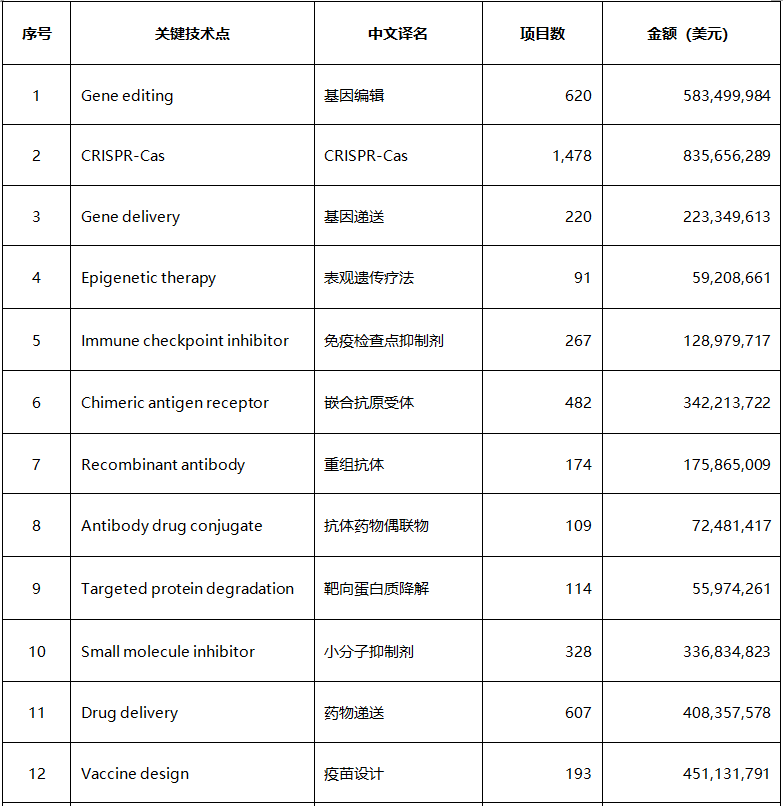
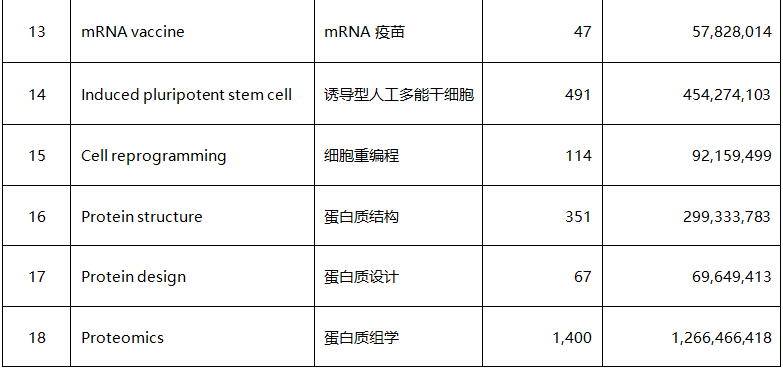
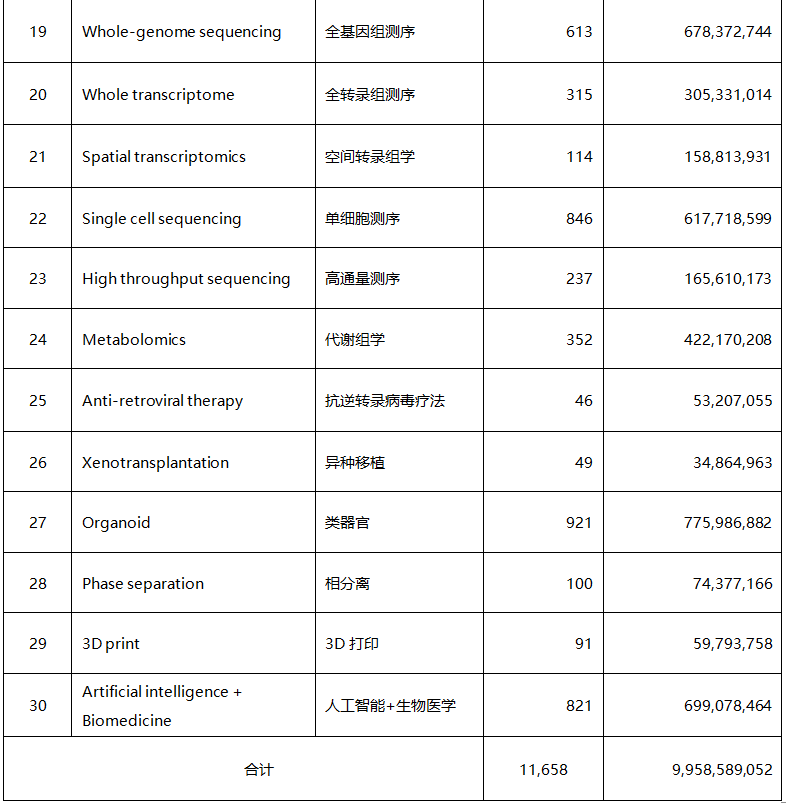
The 30 hotspots covered 11,658 ongoing research projects, accounting for 41.8% of the total sample, and received a total of 9.959 billion US dollars in research funding. Among them, the gene-editing tool CRISPR-Cas technology has the most research projects, with 1,478; Projects related to proteomics technologies received the largest amount of funding, amounting to $1.266 billion, or 12.7% of the total funding. Obviously, these key technology points are either the current key research direction of biomedicine, or the key common technologies involving future biomedicine, or the basic principle research related to future biomedicine innovation technologies. It can be predicted that these 30 technical fields that have been supported by major developed countries' biomedical research institutions will produce major technological breakthroughs in the next 5 years or so and have industrialization conditions in the next 8-10 years, thus creating new opportunities for the development of the global biomedical industry.
Different technology research heat is different. The number of projects of each type of technology is highly positively correlated with the total funding amount (see Figure 2), and the number of research projects of each type of technology and the cumulative total funding amount can basically reflect the current research popularity of this technology (see Figure 3). Among them, CRISPR-Cas and proteomics far exceed other technology points in terms of the number of funded projects or the total amount of funding, and have extremely basic applications in cancer, AIDS and other research fields.
For example, the NIH funded research project "CRISPR for Cure" (project number: UM1AI164568), undertaken by Temple University in 2021, is dedicated to developing a CRISPR-based cure for HIV. for five consecutive years (2018-2022), the Scripps Research Institute has undertaken "Chemical Proteomic Platforms for Radically Expanding Cancer. The "Druggability" NIH funded research project (R35CA231991) is committed to the continuous development of chemical proteomic platforms for the study of cancer druggability.
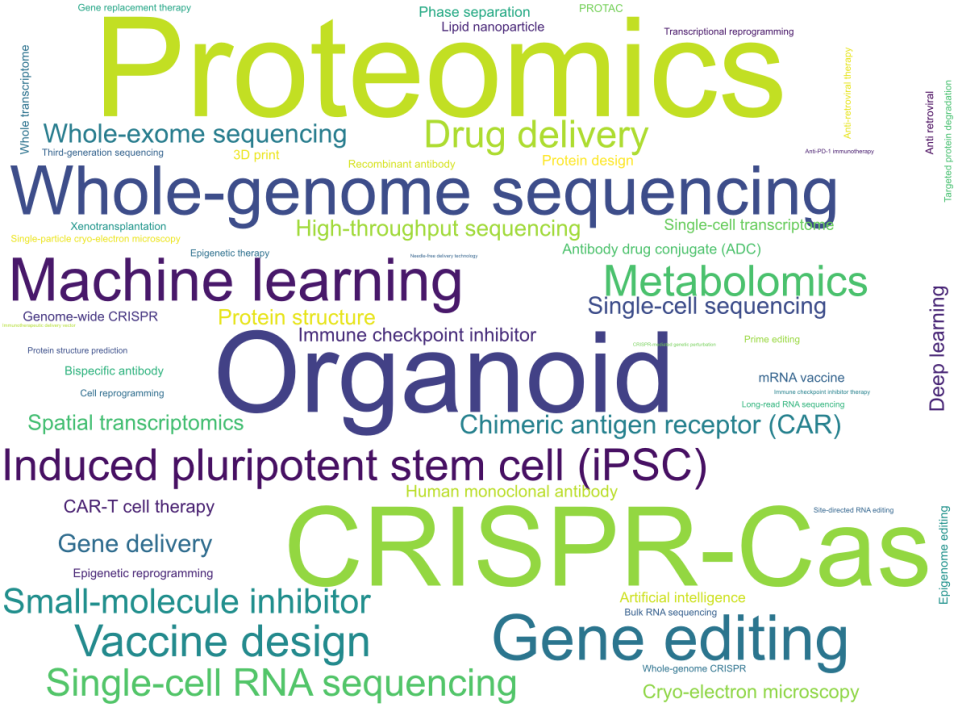
Figure 1 Cloud map of key technical point words (the size of technical point words is proportional to the total amount of funding)
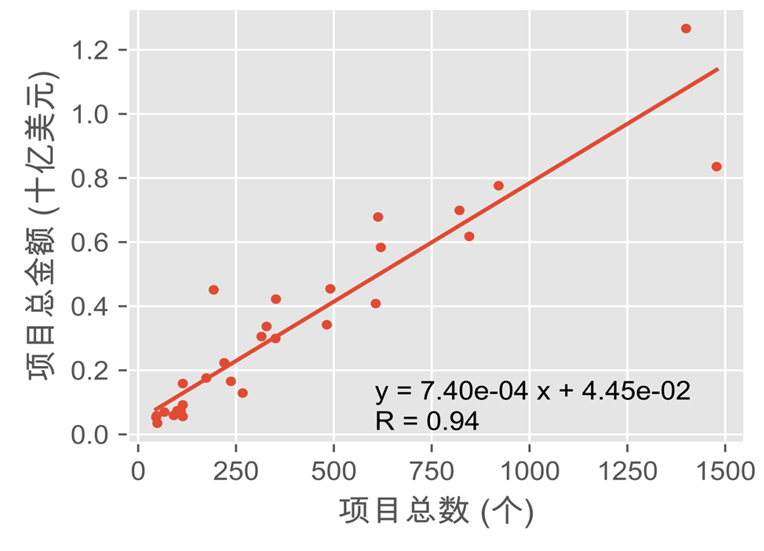
Figure 2 Linear relationship between the number of projects funded by key technology points and the total amount
Different technologies have different funding intensity. Of all 30 key technologies, the average funding for vaccine design ($2,337,500), spatial transcriptomics ($1,393,100), mRNA vaccines ($1,230,400), metabolomics ($1,199,400), and antiretroviral therapy ($1,156,700) was higher; Projects with CRISPR-Cas ($565,400), targeted protein degradation ($491,000), and immune checkpoint inhibitors ($483,100) have relatively low average funding levels. Among them, the average funding amount of vaccine design research projects reached 2,337,500 US dollars, which is the highest average funding amount of all technology points, indicating the importance of vaccine research in the context of the novel coronavirus epidemic, but also shows that vaccine research is expensive and requires strong financial investment. The difference of investment intensity among technology points indicates that there are objective differences in the demand for capital investment among different technology points, and the funding intensity should be determined according to the research characteristics of technology points themselves.
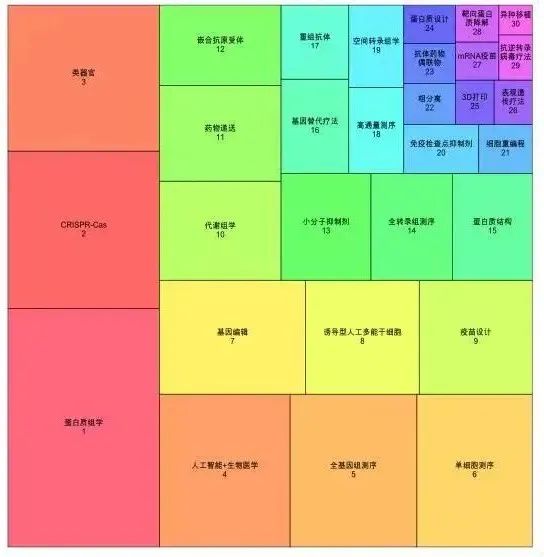 Figure 3 Research popularity chart of key technology points (graph size is positively correlated with the total amount of funding)
Figure 3 Research popularity chart of key technology points (graph size is positively correlated with the total amount of funding)
The main bodies of funding and undertaking are diversified. In order to further understand the distribution of the major funding institutions and the corresponding funded research institutions of the 30 key technologies excavated, which is conducive to researchers to further track the relevant progress, the research group analyzed the key funding institutions and the top 3 funded institutions (see the annex for details).
From the perspective of funders, the US National Institutes of Health (NIH) is the largest funder in most fields, and each funding institution is involved in mainstream key technology points such as gene editing and drug delivery, but there are differences in the layout of specific key technology points. For example, The Japan Science and Technology Agency (JST) conducts research on CRISPR-Cas, Immune checkpoint inhibitors, organoids, Xenotransplantation, and Drug delivery delivery) technical point funding projects ahead of other research funding institutions, The German Science Foundation (DFG) is working on Epigenetic therapy, Whole transcriptome sequencing, Single-cell sequencing, and High-throughput sequencing sequencing, Metabolomics and other technical points are leading the way.
From the perspective of the funded parties, universities are the main project undertaking parties, and traditional prestigious universities such as Stanford University, Harvard University, Yale University, Duke University, University of Pennsylvania, University of Cambridge and Johns Hopkins University have strong comprehensive research capabilities and strong technical reserves in many technical points. Icahn School of Medicine at Mount Sinai, Baylor College of Medicine, Massachusetts General Hospital, Boston Children's Hospital, the Scripps Research Institute and the Salk Institute for Biological Research Independent medical schools, hospitals and non-profit research institutions undertake more research projects in individual technical points and have a more in-depth layout.
2. Scientific planning of the key directions of China's future biomedical industry
In the above article, we have sorted out 30 key biomedical technologies funded by major countries around the world. It can be predicted that these key technologies invested in research will produce major technological breakthroughs, thereby creating many development opportunities for the future biomedical industry. At present, China is ushering in the golden development period of the biomedical industry, and the innovation capability of biomedicine has entered the second echelon from the third echelon in the world. At this stage, we should not only closely track the trend of global biomedical key technologies, but also focus on supporting the innovation and industrialization of several biomedical key technologies based on the characteristics of China's scientific research foundation and the potential demand scale, so as to further enhance the international competitiveness of China's biomedical industry in the process of "healthy China" construction. We will further improve the health and well-being of our people.
To sum up, based on the key biomedical technologies funded by major countries in the world sorted out and excavated in the previous section, we start from the two dimensions of technological attributes and industrial attributes of the future biomedical industry. Construct a two-dimensional index system of technology (including the importance of the general life and health safety of Chinese people, the basis of research and development in China, the difficulty of achieving the technological breakthrough through independent research and development or joint development in China) and industrialization (including the importance of driving economic growth, the expected time required for industrialization or commercial application, and the comprehensive cost of industrialization) (see Table 2). .
Based on this index system, we used Delphi expert consultation method to conduct a questionnaire survey for experts from Westlake University, Peking University, Chinese Society of Biomedical Engineering, State Information Center, some multinational biomedical enterprises and domestic biomedical start-ups. In order to identify the key technologies that have higher technological breakthrough possibilities and greater industrial economic value in our country, it will provide scientific and objective basis for formulating more targeted future biomedical industry support policies.
The evaluation of the future key directions and fields of biomedicine was conducted through the questionnaire edited by the questionnaire Star and distributed online. A total of 50 questionnaires were distributed, and 44 effective questionnaires were actually returned, with a questionnaire recovery rate of 88%. In terms of expert institutions, biomedical experts in universities accounted for 59.1%, biomedical experts in scientific research institutes accounted for 13.6%, biomedical experts in enterprises accounted for 20.5%, biomedical experts in government departments accounted for 2.3%, and experts in other biomedical fields accounted for 4.6%.
Table 2 Technical evaluation index system for key fields of future biomedicine
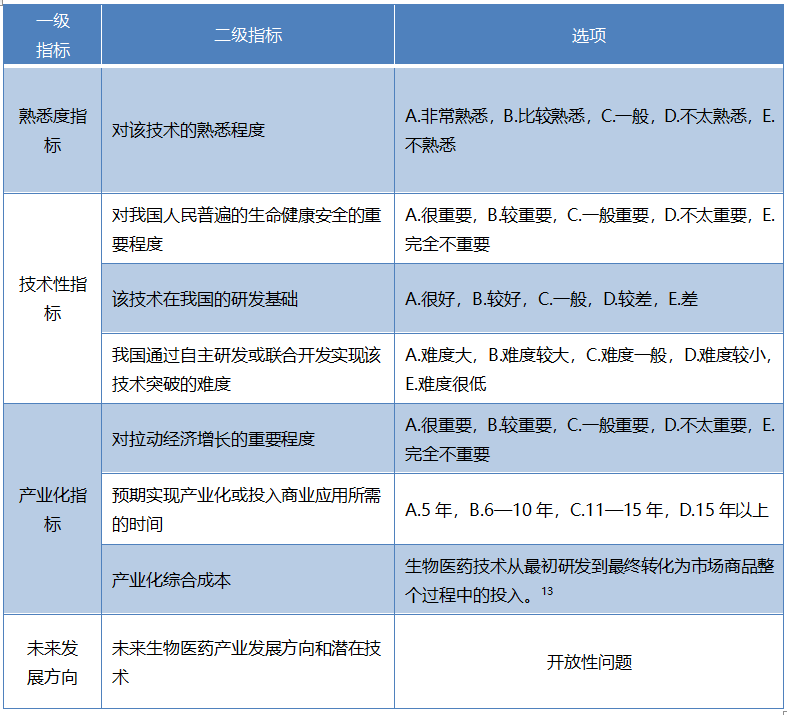
Through the assignment analysis of the questionnaire, we described and assigned the 30 key technologies in the technology pool from two dimensions: technical score (the social value of the technology and the difficulty of achieving a breakthrough in China) and industrialization score (the economic value of the technology and the difficulty of achieving industrialization in China). The final ranking results of the possibility of breakthrough and the difficulty of industrialization of key technologies in the field of biomedicine are given. Among them, the higher the technical score, the higher the social value and the less difficult it is to achieve a breakthrough in our country; The higher the industrialization score, the higher the economic value and the lower the comprehensive cost of industrialization.
Table 3 Technical and industrialization scores of key technologies in the field of future biomedicine
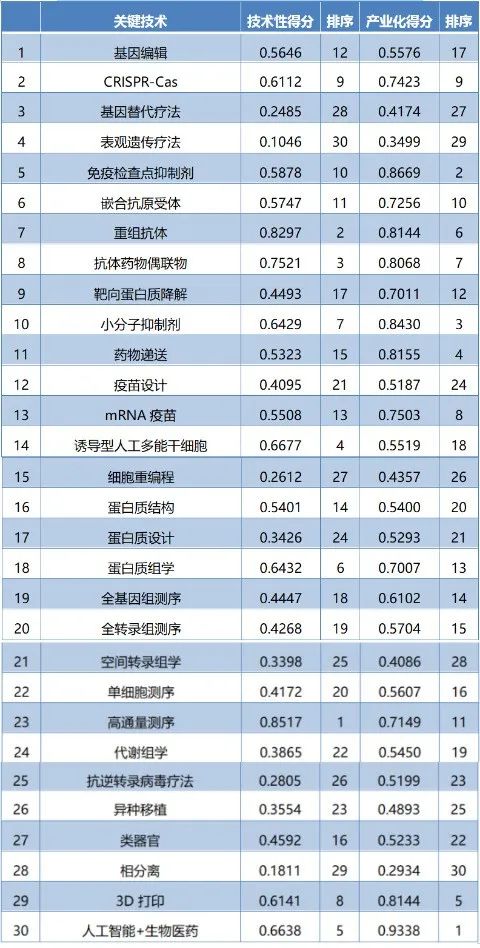
Use two-dimensional coordinate system to represent, see Figure 4
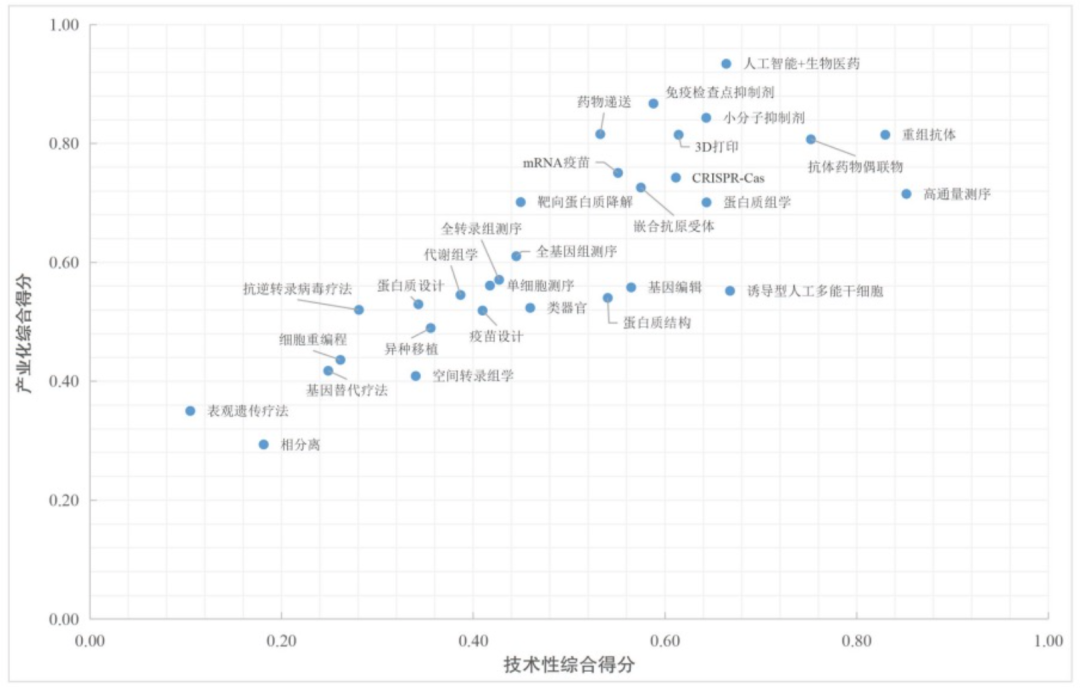
Figure 5 Comprehensive score chart of 30 key technologies
As can be seen from Figure 5, in technical terms, High throughput sequencing, recombinant antibodies, antibody drug conjugates, induced artificial pluripotent stem cells, artificial intelligence + biomedicine, proteomics, small molecule inhibitors, 3D printing, CRISPR-Cas, immune checkpoint inhibitors, chimeric antigen receptors, gene editing, mRNA vaccines and other technical comprehensive scores ranked relatively high. It reflects the high social value of these key technologies and the difficulty of achieving breakthroughs in our country. In terms of industrialization, artificial intelligence + biomedicine, immune checkpoint inhibitors, small molecule inhibitors, drug delivery, 3D printing, recombinant antibodies, antibody drug couplings, mRNA vaccines, CRISPR-Cas, Mosaic antigen receptors, high-throughput sequencing, targeted protein degradation, proteomics and other technologies ranked relatively high in overall industrialization scores. It reflects the high economic value of these technologies and the low comprehensive cost of industrialization.
As can be seen from Figure 5, the technical comprehensive score ranking of key technologies in the future biomedical industry has a certain positive correlation with the comprehensive score ranking of industrialization, that is, the key technologies with the top technical comprehensive score ranking are also relatively high in the comprehensive score ranking of industrialization. Based on this feature, we can roughly divide Figure 5 into two parts, namely, the overall technology in the upper right corner, Including artificial intelligence + biomedicine, recombinant antibodies, high-throughput sequencing, antibody drug conjugates, small molecule inhibitors, 3D printing, CRISPR-Cas, immune checkpoint inhibitors, drug delivery, proteomics, mRNA vaccines, chimeric antigen receptors, etc. The economic value and social value of these key technologies are high, the comprehensive cost of industrialization is low, the expected realization time is short, and these technologies have a good research and development foundation, and it is not difficult to achieve a breakthrough. It can be considered that these technologies are the fields with good development prospects in China's future biomedical industry, which need special attention and strong support from the aspect of industrial development.
Techniques other than the key techniques mentioned above, such as epigenetic therapy, phase separation, cell reprogramming, gene replacement therapy, spatial transcriptomics, xenotransplantation, antiretroviral therapy, protein design, metabolomics, etc. are generally in the lower left area of Figure 4-4. Although these technologies have received high attention and strong support from major countries in the world, they can be considered as areas where the development momentum of China's future biomedicine industry is still insufficient due to their relatively low economic value and social value in China, long expected time to achieve, weak technology research and development foundation, and greater difficulty in achieving breakthroughs in independent innovation. However, it must be noted that although these technologies are still highly concerned and strongly supported by major countries in the world, domestic biomedical research and development institutions need to continue to pay attention to and closely track the development of these key technologies to avoid missing the "track" unfavorable situation (see Table 4). To this end, it is necessary to further increase investment and support for these key technologies at the scientific research level.
Table 4 Policy support modes and models for key technologies in the biomedical field in the future
